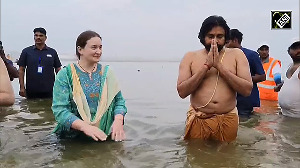Indian Space Research Organisation has shortlisted experiments from five nations, including the US, UK and Germany, for a slot in India's unmanned moon mission "Chandrayaan-1" to be undertaken by 2006-07.
"We have short listed scientific experiments from researchers in five countries -- the US, UK, Sweden, Bulgaria and Germany. We will finalise the right partners by December," ISRO sources said in Bangalore on Monday.
India plans to put a 525-kg orbiter 100 km over the moon using a Polar Satellite Launch Vehicle rocket to explore the earth's satellite.
ISRO had allotted 10 kg and 10 watt of power for space agencies of other nations and had invited international bids for the purpose that had evoked 15 responses from 10 nations.
"The best suited proposals have been short listed. We have to find out whether they finally fit into our mission payload," the sources said.
The experiments are Chandrayan-I X-ray spectrometer from Britain; Near Infra-red spectrometer from Germany; Sub-ked Atom Reflecting Analyser from Sweden in collaboration with ISRO's Space Physics Laboratory; Radiation Dove Monitoring Experiment from Bulgaria and Mini-Synthetic Aperture Radar from America.
ISRO officials will hold final talks with scientists of these projects at the International Lunar Conference from November 21 to 25 in Udaipur before zeroing in on projects that will form part of the Chandrayaan-1 mission.
India's mission is aimed at expanding the scientific knowledge about the moon, upgrading India's technological capability and providing the younger generation challenging opportunities for planetary research.
ISRO officials said a three-dimensional atlas of regions of scientific interest of the moon will be mapped with instruments on board the mission, besides exploring the lunar surface for elements such as magnesium, aluminium, silicon, calcium, iron and titanium.






 © 2025
© 2025